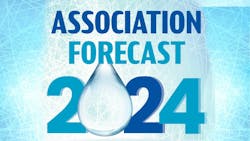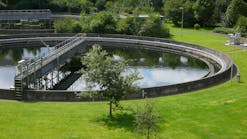With their diverse memberships, industry associations see the industry from a number of perspectives. It is these perspectives and the visions of leaders at those associations that drive the wastewater industry into the future.
In 2024, associations see an optimistic industry with a focus on big ideas, important regulatory changes and critical advancements in technology, frameworks and science.
That optimism does not come without its share of challenges, however. As state and regulatory pressures grow — particularly in regard to PFAS — rural and small utilities find themselves at disadvantages to address the matter due to economies of scale and lower capital. Funding from the infrastructure bill, however, is intended to address this matter and improve access to small and rural communities. Also informing the year are two direct potable reuse rules in California and Colorado that are setting the standard for the future of water recovery and reuse, particularly in the west.
Learn more about the intricacies of these trends and ideas from Water Environment Federation, American Water Works Association, National Association of Clean Water Agencies, National Rural Water Association and WateReuse Association in the following briefs.
Moving to a circular water economy
By Fidan Karimova, Practice Leader - Global Sustainability and Innovation, Water Environment Federation and Bianca Pinto, Biological Systems Engineer, Water Environment Federation
One strategic goal of the Water Environment Federation (WEF) is to “lead the transformation to the Circular Water Economy.” Transforming a linear economy to a circular economy is an excellent way to achieve the United Nations’ Sustainable Development Goals (SDGs) and address global climate challenges. This includes championing the adoption of circular water economy practices and eliminating barriers to their implementation.
A circular water economy (CWE), as defined by WEF, recycles and recovers resources within the water use and treatment cycle to maximize value for people, nature and businesses. It exists when the public and private sectors optimize and recover valuable resources from water and wastewater in ways that fight climate change, support equitable economic development and ensure water services for all. CWE practices keep valuable products and materials in use, regenerate natural systems, and design out waste and pollution. This model helps build a just and sustainable society and ensures it for the future.
An important aspect of a circular water economy is using nature-based solutions. These are defined as “sustainable planning, design, environmental management, and engineering practices that weave natural features into the built environment to promote adaptation and resilience” (FEMA). Back in 2018, WEF led the first-ever analysis of resource recovery by U.S. water utilities, showing significant progress in using biosolids and generating energy. Since there remains a great deal of work to be done, WEF continues to partner with others to promote sustainable and regenerative practices.
As part of this effort, WEF convened the inaugural Circular Water Economy Summit in July of 2023. This event connected experts from the energy, food and beverage, technology, automotive, and agriculture sectors, among others, with their counterparts in the water sector. Participants appreciated the opportunity to share approaches that had helped them operate more sustainably while hearing innovative solutions from other sectors. Along with additional initiatives to promote CWE adoption, WEF is convening a second CWE Summit this year (July 15 to 17, 2024).
In 2024, WEF efforts will continue to emphasize how deeply the water sector is interconnected with other industries and how cross-collaboration is critical to achieving a truly circular water economy.
A continuation of shared optimism
By Barb Martin, Director of Engineering & Technical Services, American Water Works Association (AWWA)
For more than 20 years, AWWA’s State of the Water Industry survey has captured water sector attitudes, challenges and trends. Its 2023 results continue a trend of optimism, which began prior to the pandemic, reporting the second-highest levels of water sector optimism seen over the past decade. The survey revealed additional shifts in perspective. Long-term water supply availability eclipsed financing for capital improvements to rank second on a list of the sector’s top challenges, behind only renewal and replacement of aging water infrastructure, which has consistently ranked as the water sector’s top challenge over the past five years — a shift based on the unprecedented levels of funding currently available for water.
What does this mean for 2024? Although challenges and uncertainties remain, continued water sector optimism is projected for the coming year. This outlook is based on the sector’s response to challenge and uncertainty, along with the technological advances and innovations with the potential to transform the future of water.
As demonstrated during the pandemic, the water sector continues to rise to the occasion to address water’s most intractable challenges. A growing number of utilities are considering potable reuse to address water supply challenges and augment source water supplies. Utilities are actively implementing climate action plans, ensuring resilience through climate mitigation and adaptation measures. Efforts continue to optimize efficiency at the water/energy nexus, through technology, asset management, and behavior change, with the potential to reduce our sector’s climate impact. The rapid adoption and evolution of generative AI in the water sector will transform all aspects of water, with access to new technologies driving the democratization of water data and knowledge and advancing water equity.
Finally, the leadership of water professionals drives my optimism for the coming year, as we continue to collaborate to support communities most in need, advance our collective knowledge, and boldly drive action to ensure a successful and sustainable future for water.
PFAS, policies and politics
By Kristina Surfus, Government Affairs Managing Director, National Association of Clean Water Agencies (NACWA)
The clean water industry will continue facing persistent and growing challenges in 2024 ranging from managing workforce issues and ever-rising costs, addressing affordability and customer inability to pay, responding to new regulations, and communicating effectively with customers to build public trust. As public clean water agencies tackle these issues in their day-to-day, NACWA works to elevate concerns with federal agencies and Congress and communicate the critical role of the public clean water sector.
In 2024, federal attention will be directly driven by the political calendar. With the November elections for president, the entire House of Representatives, and a third of the Senate looming, the Biden Administration is working quickly to wrap up its regulatory priorities before fall in case of an Administration change. Congress, likewise, will be looking to wrap up their “must do’s” and notch a few wins in the first half of the year, allowing members to then turn their focus to campaigning at home.
Within that politically charged setting, NACWA will be laser focused on communicating the role of public clean water utilities as essential institutions supporting public health, the environment and jobs in their communities. That includes pushing back on false narratives labeling utilities as “polluters” rather than guardians of a clean and safe environment. Utilities have earned the right to a role in shaping constructive solutions to environmental challenges through a collaborative relationship with federal policymakers.
PFAS is one area where this focus will be essential in 2024. The U.S. EPA is proceeding with its final rulemaking designating PFOA and PFOS as hazardous substances under the Comprehensive Environmental Response, Compensation, and Liability Act (CERCLA) this spring. The designation under CERCLA would drive PFAS cleanup — despite that, PFAS chemicals are still used in commerce and have yet to be regulated under other relevant statutes including the Clean Water Act. NACWA supports a more logical approach and greater controls on PFAS before they enter waste streams and the environment. EPA has acknowledged that clean water agencies are passive receivers of PFAS, but statutory clarity to protect utilities and their customers from paying for pollution that industry caused is needed. This can be achieved through a targeted CERCLA exemption from PFAS liability for clean and drinking water utilities.
Federal funding is also a hot topic in 2024. Following recent years’ historic federal water funding increases, the political winds have shifted to put severe downward pressure on federal spending. As January begins, Congress remains in a protracted battle over Fiscal Year 2024 spending levels. These debates do not target water investment itself, but water investment is caught in the dragnet. Fortunately, the previously-appropriated Infrastructure Investment and Jobs Act (IIJA) and Inflation Reduction Act (IRA) dollars, which are just starting to flow out of federal coffers, will buffer clean water programs from immediate impacts. But it will be essential for future funding years that NACWA continues to vocally defend clean water as a core federal funding priority.
Despite the political noise, 2024 may shape up to be an impactful year for clean water policy. It is critical that the clean water sector remain closely and collaboratively engaged with federal policymakers to elevate our priorities.
Small systems struggle under federal pressures
By Charles Stephens, Senior Executive Policy Director, National Rural Water Association
As 2023 winds down, the National Rural Water Association (NRWA) is reflecting on accomplishments achieved this year and is energized for the year ahead. The water/wastewater sector has many challenges, but three stand out: PFAS, the Lead and Copper Rule Improvements (LCRI) and Cybersecurity. In each of these instances, rural water and wastewater systems are disproportionately impacted due to small populations and lack of economies of scale. Rural communities should be considered in legislative and regulatory actions impacting the water sector, and NRWA will continue advocating on their behalf.
Regarding PFAS, NRWA’s focus is protecting water systems and their customers from the potential billions of dollars in legal liability, remediation costs, and reputational risks associated with EPA’s proposed hazardous substance designation of PFOS and PFOA under the Comprehensive Environmental Response, Compensation, and Liability Act (CERCLA). CERCLA is intended to uphold a “polluter pays” principle. However, absent a statutory exemption from PFAS liability for drinking water and wastewater systems that passively receive PFAS, polluters could pass these costs on to customers, effectively creating a “public pays” principle.
PFAS testing and treatment costs are already placing significant financial burdens on our communities, and a designation of PFAS as a hazardous substance will only exacerbate that cost. This burden cannot be overlooked, and equitable solutions must be identified. Rural Water strongly supports the “Water Systems PFAS Liability Protection Act” legislation, introduced by Senator Lummis, which aligns with the goal to eliminate PFAS from the public’s drinking water while preserving the essential “polluter pays” principle.
Continuing to address cybersecurity must be a priority for all drinking water and clean water systems.
Finally, NRWA applauds EPA’s effort to protect public health by removing lead from our nation’s drinking water. With the help of our 50 state affiliates, NRWA will help systems meet the LCRI’s ambitious goals, while also continuing to provide technical assistance and training each day. As an inaugural member of the “Get the Lead Out” Partnership, NRWA and our state affiliates have been committed to this initiative from day one. As details of the LCRI are reviewed, NRWA will continue working with EPA to ensure our members are prepared to meet the challenges that lie ahead.
There are sure to be challenges Rural Water will face in 2024, but there will also be ample opportunity to continue the vital work we do each day. There is nothing we cannot accomplish when government and industry come together to ensure everyone has access to safe drinking water and clean wastewater services.
Removing barriers, elevating opportunities in 2024
By Patricia Sinicropi, Executive Director, WateReuse Association
We are experiencing a critical moment for water reuse. New funding, new collaborations and new regulatory frameworks are elevating opportunities for reuse projects across the United States and globally. These efforts will create cleaner environments, more reliable water resources and overall economic opportunities, but they require collaboration and advocacy to succeed.
Collaboration is critical to successful water reuse projects, and 2023 saw many new and fruitful partnerships come together within our sector to advance water reuse. The WateReuse Association worked in partnership with other water associations to advocate for PFAS remediation paid for by the polluters so that ratepayers are not stuck with the costs of this clean-up. We collaborated with The Water Research Foundation on a major National Priorities project funded by the U.S. Environmental Protection Agency to unlock the nationwide potential for water reuse. Our members and sections forged deeper collaborations with associations, utilities and stakeholders to advance projects in their respective states, including Florida Water Reuse Week, Colorado and California’s landmark Direct Potable Reuse rules, and Oregon legislation requiring regulatory updates to support water reuse. In addition to this advocacy work, our sections collaborated with local partners to hold state and regional conferences in Arizona, Colorado, California, Florida, Nevada, Texas and Washington.
In 2024, the WateReuse Association and our members will focus on removing barriers and empowering safer, more resilient, and more sustainable communities and businesses by elevating opportunities for water reuse.
We will continue to maintain our State Policy and Regulatory Map, to help water utilities understand opportunities amidst a rapidly changing landscape of state regulations. We will host a summit for wastewater and water reuse state regulators at the 2024 WateReuse Symposium in Denver, Colorado. And we will lift up local reuse advocates, supporting the formation of new WateReuse regional sections in Ohio, Oklahoma and beyond.
In the year to come, we will also work to align policy and regulatory incentives to facilitate greater adoption of reuse among industrial and commercial facilities. We know that water fuels our economy and large consumers of water, such as data centers, advanced manufacturers, food and beverage companies, and the energy sector, are becoming more aware of their water footprint and making commitments to use water more sustainably, and are incorporating water recycling into their water management portfolio. The WateReuse Association looks forward to working with industry leaders to showcase how water recycling is supporting their efforts to build more resilient operations and deal with risks associated with climate change.
Another trend to watch out for is increased focus on harnessing the co-benefits of water reuse to protect and restore environmental resources. WateReuse Association recently published a summary and case studies on environmental restoration, showing how water reuse benefits waterways, wetlands and aquifers. This topic will take center stage in the opening plenary of the 2024 WateReuse Symposium: “Restoring Our Natural Resources through Reuse,” a panel that will include utility directors from across the United States. You can join us March 11-14 in Denver, Colorado, to hear this important presentation and many more.
As many end-uses, funding streams and co-benefits of water reuse gain traction, the opportunities for water reuse have never been greater. Let’s transform our water future together!









